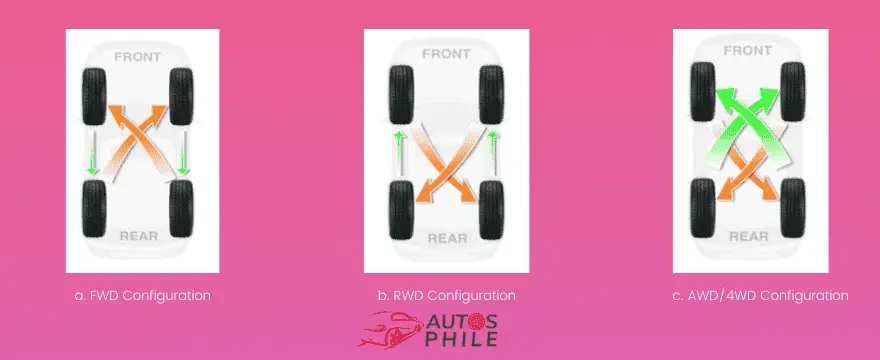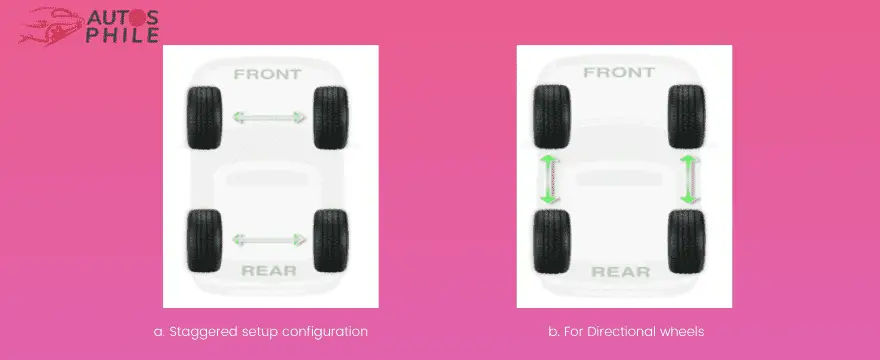Most buyers when they look for a car, they look for a specific model, body style, engine horsepower, or even color.
One thing buyers often neglect and also many car owners are guilty of overlooking it as well, are the tires of the car.
Tires are arguably the most important component of your car when it comes to overall safety on the road.
Tires are responsible for supporting the vehicle’s load, providing traction for braking and acceleration, maintaining steering, and absorbing road shocks.
After all, it’s literally where the rubber meets the road.
What is tire rotation?
“So, what is tire rotation?”, “Don’t tires rotate all the time while driving?”. These may be some of the questions popping in your mind right now.
Put simply, tire rotation means shuffling the position of your tires (in a specific pattern) every 5000-10000 miles.
The exact figure may vary for each case depending upon the manufacturer, model of the car, condition of the tires, etc., and we recommend checking your owner’s manual for exact details, but shuffling every 5000-7000 miles is OK and good practice too.
Why is tire rotation important?
Tire rotation allows you to basically get even wear on the tread of your tire.
Tires do wear differently depending upon the axles being driven so tire rotation is done to mitigate the possibility of some tires of the car getting worn out quicker than others.
It will allow you to utilize all of the available treads on the tire, get the most even wear, and ultimately extend the lifespan of your tires.
Tire rotation is all about getting the most out of your tires.
So, with the hundreds of dollars, you spend on your tires, you’re going to get the most out of your money through tire rotation.
What if you don’t rotate your tires?
Rotation is a critical part of your tire maintenance. Regular maintenance of tires is in the best interests of the car’s fuel economy, handling, and obviously safety on the road
If you do not rotate your tires regularly, it can cause uneven tread, reduced lifespan of tires, poor traction on road especially slippery surfaces – ultimately
leading to less safety on the road which can result in fatal accidents.Poor maintenance can lead to premature tire wear, the appearance of cracks on the tires, a flat tire, or even a blowout which can lead to terrible accidents and in the worst-case scenario fatal ones.
Following are some of the problems you may face with your tires if they are not regularly rotated:
1. Uneven wear of tread
Tires that are not regularly rotated get uneven wear across the tire tread pattern which means some of the tires will wear out quicker than others.
Generally, the front wheels get worn out quickly as they take a larger proportion of the torque and friction required for turning, accelerating, and braking. This may cause certain drivetrain problems in front-wheel drive vehicles.
2. Edges on tread
Tires driven a lot without regular rotation may get “high and low spots” on the tread, which almost feel like edges when you rub your palm around the tread.
This occurs due to unequal utilization of tread which may be a direct consequence of not rotating the tires at regular intervals.
3. Vibration and Noise
With uneven wear on the tread, you are susceptible to hear more vibrations and noise coming from the tires of the car which may foil a comfortable journey.
4. Shorter life-span
Tire rotation is all about extending the lifespan of your car by utilizing all of the available tread.
So, you lose out on that extra lifespan of your tires and get less value out of the money you spend on your tires.
How to rotate your tires?
Tire rotation is not at all difficult and you can do it on your own quite easily.
But tire rotation does not mean randomly shuffling the tires of your car.
There are specific patterns and recommended configurations depending upon the type of car that needs to be followed to get the benefits of a tire rotation.
Jack your car up, remove the lug nuts and the tire from the car, and shift them in the appropriate place according to the following guidelines:
(Helpful hint: Make sure you are using the correct torque spec when tightening the wheels and tires. Refer to your owner manual for exact details)For square wheel and tire setup
If you’re running a square wheel and tire setup i.e., the front wheel and tires are of the same size as the rear wheel and tires, you would want to follow the following patterns:
a. Front wheel drive (FWD) Cars
For front-wheel-drive cars, the front tires are going to go straight back replacing the rear wheels and tires and the two rear wheels and tires, are going to get crossed and brought up to the front.
b. Rear wheel drive (RWD) Cars
This would be the opposite configuration of FWD Cars. The two rear wheels will get brought up to the front and the front wheels would get crossed and installed to the rear.
c. All wheel drive (AWD) Cars/ Four-wheel Drive (4WD) Cars
For an all-wheel-drive vehicle, the recommended configuration is to actually cross both of the rear tires upfront and also cross the front tires and install them at the back.

For Staggered Setup and Directional Wheels
- For a staggered setup (i.e., when the rear and front wheels are not of the same shape and size), the only way you can rotate these tires is where they stay on the same axle. So, the rear left will switch with the rear right, and the front left will switch with the front right.
- For directional tires, the tires are moved from one axle to the other but remain on the same side of the car, i.e., front right gets shifted to rear right and front left gets shifted with the rear left.

Is it OK to rotate tires every 10000 miles?
It is recommended by manufacturers and a lot of car experts as well, to rotate your tires every 5000-10000 miles or six months or every time you go for an oil change.
Hence, it is certainly OK to rotate your tires after 5000-10000 miles as it will certainly enhance the lifetime of the tires and save them from uneven wear.
Conclusion
The bottom line is that tire rotation is critical and recommended part of your tire maintenance.
It extends the life of your tire by promoting even wear on the tread and utilizing all of the available treads on the tire.
Tire rotation should be done every 5000-1000 miles or according to the distance mentioned in the owner’s manual by the car’s manufacturer.
Tire rotation should be done according to the specific patterns listed above for the different types of vehicles (FWDs, RWDs, 4WDs, etc.).
When done correctly, tire rotation gets you the most value out of your tires and gets you the best bang for your buck on the money spent on tires.

